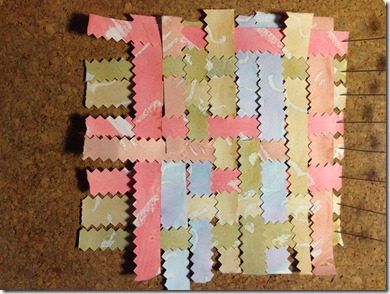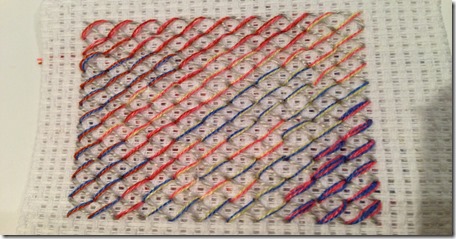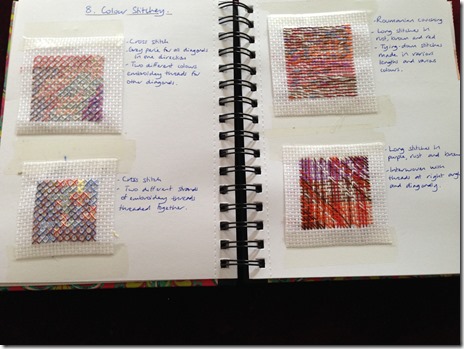My resolved samples are based on the woven paper design shown in 9.1 in the previous chapter.
Resolved sample 1
This sample was made using a wide variety of threads and wools on a canvas background. I used coloured watercolour pencils directly onto the canvas to loosely translate the blocks of colour shown in image 9.1 to act as a guide to my choice of thread colours.
I started by covering most of the canvas with basic straight stitches woven in and out of the canvas to create a stitched base. Once the canvas was almost covered I started building up the height and textures using a wide variety of stitches that I had tested in Chapter 7. I used a thick cream wool in a detached chain stitch to create the higher areas of the surface. I particularly liked using French knots and bullion knots in threads and silk ribbons to create height and contours. I used button-hole stitch and stem stitch to help create more organic looking areas which were slightly fossil-like.
I mainly used embroidery cottons and perle threads as I wanted this piece to be vibrant and silky in contrast to the piece I produced in Chapter 7. See image 10.1 below.
10.1 – Resolved sample 1
Resolved sample 2
For this sample I decided to use freestyle machine quilting to create a representation of the colours and textures of the woven paper sample. The base of my piece was cotton wadding. I used strips made from muslin, wove them and stitched the woven piece to the backing around the perimeter. I wanted the edges of each strip to fray to help give texture to the piece and so loosened the threads on the edges prior to stitching them in place. I then machine embroidered using threads to represent the colours in the woven paper sample. I stitched using circular designs as this produces a pleasing difference in heights with the unstitched centres of the circles ‘puffing up’ in contrast to the stitched parts. See 10.2 below.
Image 10.2 – Resolved sample 2
Overall, I am very satisfied with these resolved pieces. I have enjoyed the creative journey that I have taken over the last three months on this foundation course and have produced work which I would not have anticipated creating at the start. I feel that the pieces are more liberated in their style than I thought I could produce. I look forward to starting the next module.









